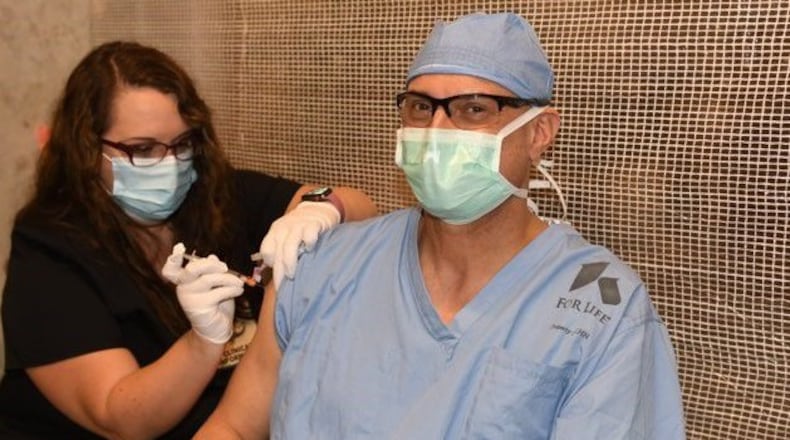Monday Ohio National Guard members on the front line of the state’s pandemic response began receiving vaccinations through a Department of Defense effort.
“I’m getting vaccinated because my wife’s a teacher and I want to make things easier for her,” 1st Lt. Zachary Cook, also with the 37th Infantry Brigade Combat Team, said in a statement. Cook is the officer in charge of the food bank mission in the Cincinnati area and urged others to get vaccinated. “It is absolutely recommended to get the vaccine. It is safe, it’s effective by every measure that the CDC (U.S. Centers for Disease Control and Prevention) has put out.”
About 500 Guard members who are assisting in missions at long-term care facilities, COVID-19 testing sites, and food banks are expected to be vaccinated. The Department of Defense program is separate from Ohio’s state vaccine distribution effort.
Kettering Health Network said Monday that it had expanded to vaccinating health care workers at Soin Medical Center and Sycamore Medical Center, with more locations starting later this week as quantities allow.
In this first rollout that is underway, called Phase 1A, vaccines are being given to:
- Ohio health care workers and personnel who care for COVID patients
- Residents and staff of nursing homes, assisted living facilities, and veteran’s homes.
- Psychiatric hospital patients and staff
- People with developmental disabilities and those with mental illness, including substance use disorders, who live in group homes or centers and staff at those locations
- EMS responders.
Health system still under strain
Spread of the disease and hospitalizations remain high and health capacity is strained, according to state data released Monday, but the number of Ohio COVID-19 hospital patients reported has declined over the last two weeks. Statewide, cumulative COVID-19 cases surpassed 675,000 on Monday.
In response, the Ohio Department of Health urged Ohioans host or attend a virtual party in a social media post.
“Send noisemakers and party hats to friends and family in advance, then have everyone sign on before midnight to welcome 2021!” the post read.
In the Dayton-area’s local hospital region, about 1 in 4 patients are COVID-19 positive and about 1 in 4 ICU patients are COVID-19 positive, according to the Ohio Hospital Association.
On average, each day last week local hospitals had at least 12% of their patients with COVID-19, according to hospital-level capacity data released Monday by the Centers for Disease Control and Prevention. Soin Medical Center had the highest daily average, with 36% of hospitalized patients positive for COVID-19, according to the CDC data.
U.S. health officials believe the coronavirus mutation that set off alarms in parts of Britain is no more apt to cause serious illness or be resistant to vaccines than the strain afflicting people in the United States but it still must be taken “very seriously,” the government’s top infectious disease expert said Sunday.
In an Associated Press report, Dr. Anthony Fauci, the director of the National Institute of Allergy and Infectious Diseases, said Sunday the U.S. is at a critical phase of the pandemic, with the worst probably still ahead. He predicted the general population would be getting immunized widely by late March or early April — beyond the front-line workers, older people and certain other segments of the public given priority for the vaccines.
Associated Press contributed to this report.
About the Author

